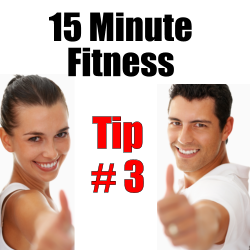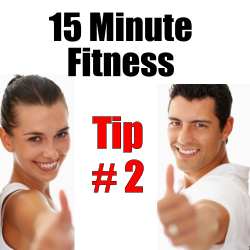Even if you can’t find a large chunk of time in your day, there are some things you can do to take advantage of small chunks that you may have throughout the day. Below are 5 tips on how to work in some exercise into your day.
1) Dress for the Occasion
Many times the desire to exercise diminishes if you have to go and get changed into your workout clothes. Or maybe by the time you got changed, your “window of opportunity” is gone. The way around that issue is to put on your workout clothes right away when you get up. That way when an exercise opportunity comes up, you can take advantage of it right away.
2) Be Prepared
If you do have small chunks of time that show up during your day, have a routine or workout ready that you can do in that amount of time. There are many 10-minute workouts available on the Internet. Studies have shown that three 10-minute sessions per day are actually better than one 30-minute session.
Also, have a longer routine ready that you can do if you get a longer chunk of time, such as 30-minutes. Maybe a run or walk planned or an exercise video. Otherwise, you may squander away an opportunity trying to think what you could do in that amount of time and end up not doing anything.
3) Exercise Together
You don’t have to exercise alone. If your kids are younger, think about buying an exercise stroller where you can jog while pushing the stroller ahead of you. If your kids are older, have them exercise with you. Not only will the exercise do them good, but you will be instilling the healthy exercise habit in them.
4) Ask for Help
Make time for you to get out and exercise whether that is a jog around the neighborhood or going to a gym. If you have family in the area, ask a grandparent to watch your kids for a couple hours once or twice a week. Arrange for your spouse or significant other to watch the kids once s/he is home while you go exercise. Or hire a babysitter to come in once or twice a week for an hour or so – anything that can get you out of the house and to exercise.
5) Buy your own personal trainer
No, I’m not talking about buying a person that comes into your home to work with you, but you can have the next best thing by buying a few exercise videos. It is almost as good as hiring a personal trainer. There are loads of videos available regardless of your fitness level, from those just starting out to exercise boot camps for the more advanced fitness buff. Having exercise videos makes it easy to pop one in the DVD player and work through a session while your kid is napping in the afternoon.
6 Fitness Ideas For Couples
Ninety-four percent of couples that work out together stick with their fitness programs for the long-term. Part of the reason for the high success rate is accountability of one partner to the other. By each motivating the other, one would let the other one down by not working out.
Couple fitness differs from partner fitness in that there is a deeper commitment to make the other one happy. Once the workout is over, partners usually go their separate ways, however with couples, they go home together.
While there are several different types of couple physical activities, some lend themselves to working out together better than others. Here are six exercises that are great for couples.
Zumba
Based on several different Latin moves, including salsa and hip-hop, what can be more enjoying than watching your partner move to the music. While dependent on weight, duration and intensity, you can burn between 325 to 725 calories in an hour-long class.
Water Aerobics
Exercising in water lends itself well to couples fitness as water aerobics is usually in a group setting anyway. Depending on your weight, you can burn anywhere from 350 to 500 calories during an hour class.
Cycling
Whether you cycle on separate bikes or on a bicycle built for two, cycling is a great way to both burn calories and spend time together outside. Leisure biking at 10 mph burns about 300 calories per hour. Power biking at 24mph can burn up to three times that amount.
Tennis
Regardless if you play singles against each other or as a couple, tennis is a great workout and a good way to learn how to work together as a team. An hour-long game can burn up to 345 calories for a man and up to 590 for a woman.
Weight Lifting
While all of the other exercise activities in this article are cardio-centric, weight lifting is great for couples who want to do strength training. One can spot while the other one lifts; then switch around. A 150-pound person can lose up to 300 calories in an hour-long session.
Resistance Training
Partner-assisted resistance training can run from kickboxing, to throwing a medicine ball, to pulling against each other using a fitness band and everything in between. An hour session burns around 300 calories.
And who knows, spending all this quality time together exercising could trigger a spark to another great couple exercise activity – lovemaking. A 30-minute romp between the sheets burns around 145 calories. And for more ideas take a look at “How to Make Exercise More Fun” and Enjoy!







